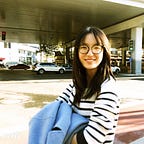Midterm Progress Sketch
Sam Stomberg, Forrest Brandt, Rita Ling, Yuetian Wang, Professor Kimiko, INFO C262
General Idea
Using LEGO pieces as the tangible input and research the output.
Use Case - enabling modular construction blocks to be both infinitely reusable and idea-preserving.
There is a tension in building with LEGO (or other construction systems), where a modular component that could play a large number of different roles is assigned to one in particular; conversely, once an object has been built, continuing to use it prevents the pieces from being recombined in a different way. We propose an interface that would enable fluid movement between the tangible world of constructed objects and a digital space in which they can be saved and interacted with.
The modality of digital-capture-and-collaborate that our group is exploring enables users to have both — preservation (and editing) of their creations while breaking the original apart and building something new. The digital representation of the object could be augmented — with new colors, light or sound effects, motion, interaction, or even material properties not possible within the original system (stretching or shrinking, bending). And where many digital spaces (e.g., Minecraft) use a low-granularity grid seemingly inspired by LEGO to constrain placement and movement, the capabilities needed to capture and manipulate complex physical objects will also enable smoother, more “analog”-feeling spatial relationships.
The shared digital space can be a site of collaboration and learning — being able to modify and play with someone else’s creation without disturbing their instantiation removes some of the competitive / possessive qualities of building-set play. Radical changes to the constructed object (e.g., what if it was built from wet sand on a beach or sculpted from ice) or learning through disassembly, such as identifying parts / components of a house, can be easily enacted on the digital representation, and provide a personal touch-point.
Use Case - Design tools for designers and people without design background
For professional use, architects, landscape architects, and urban planners could design together by using LEGOs. Doing conceptual design in LEGOs could save a lot of time doing digital models on computers. Also, designers put thoughts in LEGO together to make the design more seamless. For non professional use, people without design background could show their ideas by easily assemble LEGOs, which is stronger than verbally description and easier than hand drawing.
Use Case — Education of the Natural World
This design is inspired by both LEGOs and playing in a sandbox. Users can build using the natural world around them, and the building block information is transferred into a digital representation. Users are able to explore their creations and dive further into learning more details if they so desire. For instance, a user uses a leaf to build a tree. That leaf represents a specific type of tree which is now identified, where birds and other creatures live. Audio of birds chirping and visuals can be included to enhance the sensory experience of this design. Users can play independently or collaboratively, just like in a sandbox, to explore their surroundings.
Use Case — social media for kids or enlightenment for children in landscape architecture
Children can use it as the social media. Some kids can use LEGO to build some private or open space, and they share these spaces online and invite their friends to engage in. Their friends can enter the space online, and add some virtual elements to make the space more specific and beautiful. After they wear AR glasses, they seem to be in a real space and be able to chat face to face.
Meanwhile, if some kids are interested in architecture or landscape architecture, they can use LEGO to build buildings or cities, and reflect it to the computer. And they can also change the size, the color of the blocks, add or delete the buildings, add different materials in the virtual model in the computer. And then, the model in the computer can reflect the change on the physical model through the laser camera.
